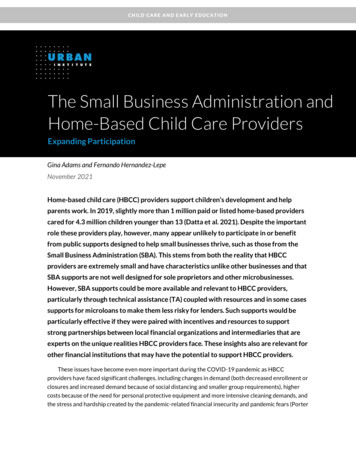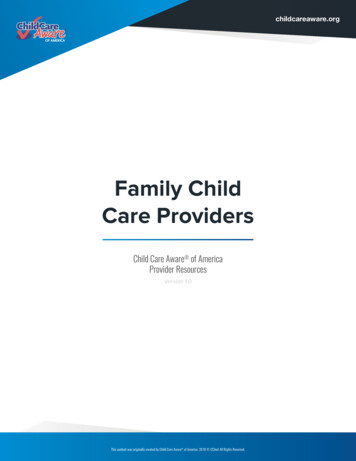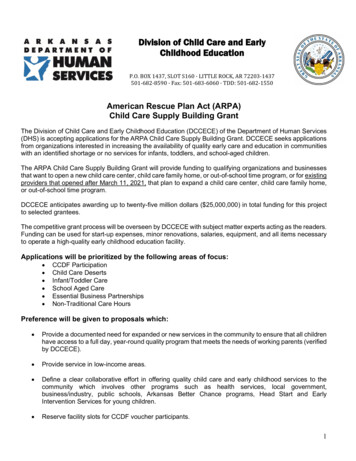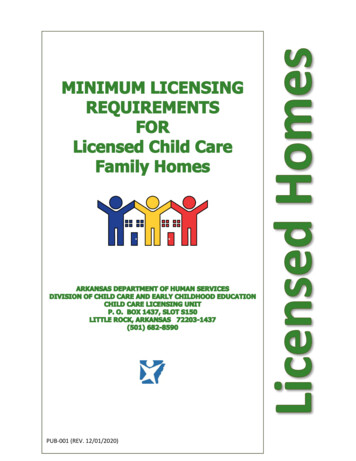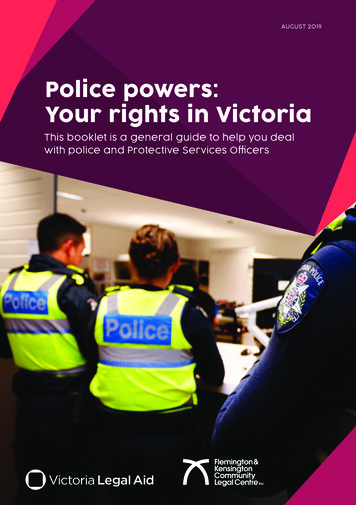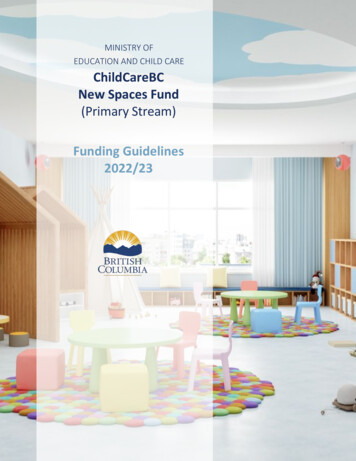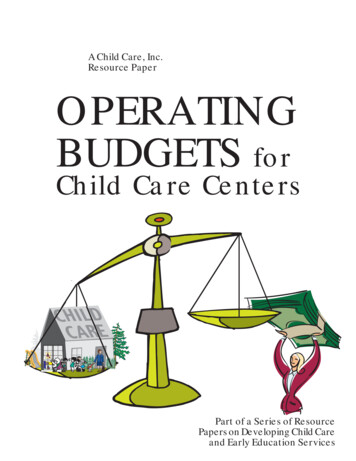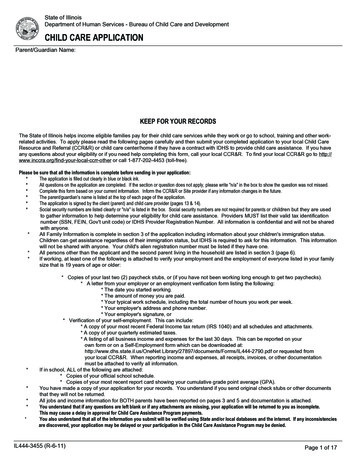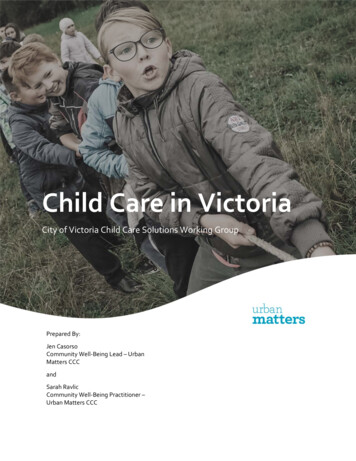
Transcription
Child Care in VictoriaCity of Victoria Child Care Solutions Working GroupPrepared By:Jen CasorsoCommunity Well‐Being Lead – UrbanMatters CCCandSarah RavlicCommunity Well‐Being Practitioner –Urban Matters CCC
AcknowledgementsThe City of Victoria is located on the traditional territories of the Songhees andEsquimalt Nations.We would like to thank the Child Care Solutions Working Group for their input and participation in thedevelopment of Child Care in Victoria: Quadra Village Community CentreCity of VictoriaDepartment of Education, Government of B.C.Ministry of Children and Family Development, Government of B.C.School District 61Camosun CollegeIsland HealthFernwood NRGBurnside Gorge Community CentreOaklands Community CentreVic West Community CentreVictoria Chamber of CommerceChild Care Resource and Referral CentreFairfield Gonzales Community Association
Table of Contents01Executive Summary. 202Introduction . 403State of Child Care in the Community. 604Methodology. 705Role of Community in Child Care . 906Role of Government in Child Care . 1007Gap Analysis .1508Child Care Space Inventory . 2409Child Care Demand & Space Creation Targets . 32010Recommendations . Error! Bookmark not defined.011Conclusion. 40AppendicesAppendix A ‐ Engagement Summary . 43Appendix B – Child Care Provider Survey Questions . 61Appendix C – Stakeholder Interview Questions . 66Appendix D – Focus Group Questions . 67Appendix E – Appendix F ‐ Child Care Facility Requirements . 68Child Care Report – City of Victoria1
01 Executive SummaryWith growing waitlists and child care shortages across the province, there is aneed for a comprehensive and strategic approach to child care.Understanding and improving the state of childcare is a provincial priority with multiplesources of funding available for municipal childcare needs assessments and capital spacecreation programs. Child Care in Victoria is theresult of a successful application to theCommunity Child Care Planning Program. TheReport was informed through a regionallicensed and license‐not‐required child careinventory, community profile and policyanalysis, and a robust engagement process thatincluded both quantitative and qualitativeanalysis.The following report highlights the projectfindings after engaging with parents,caregivers, child care providers, and otherstakeholders through surveys, focus groups andkey informant interviews. A licensed child careinventory was developed to understand thecurrent child care supply, while demand wasunderstood through quantitative andqualitative engagement combined with City ofVictoria child population projections andbenchmark space creation targets provided bythe Ministry of Children & Family Development.This study outlines the current child caresituation within the City of Victoria only andprovides information regarding gaps, needsand targets for child care space creation. TheReport includes direction regardingrecommendations for partners to address theidentified gaps.This study catalogued a total of 2,817 licensedand license‐not‐required child care spacesacross the City with a current gap of 4,233 childcare spaces.Child Care Report – City of VictoriaCurrent Child Care Spaces GapAges 0 to 5Ages 6 to 122,814 spaces2,049 spacesOver a 10‐year horizon with an ideal scenario of50% coverage for non‐school‐aged children (0 –5) and 80% for school‐aged children (6 – 12) thefollowing annual space creation targets areneeded:Space Creation Targets per yearAges 0 to 5Ages 6 to 1228 spaces128 spacesAs we look to increase the number of child carespaces within the City of Victoria over the nextten years, systemic child care challenges mustalso be considered; and a multi‐dimensionalapproach is required to improve child care inthroughout the region and not just within theCity boundaries to create transformationalchange.2
Our recommendations and actions are grounded on the province’s goal to move towards UniversalChild Care or improving access to affordable licensed care. We propose five main recommendationareas. With each recommendation, the Report has outlined actions, roles, timelines, outcomes, andmeasures of success to help move the region towards a more sustainable child care rove processesDevelop or refine plans andpolicies with child care in mindLeverage partnerships toaccess funding to “unlock”underutilized assets ordevelop new onesAdvocacyEducation & TrainingAdvocate to higher levels of government forenhanced local fundingReduce the knowledge gap for parents tryingto access care and for providers looking tostart‐up or expandChild Care Report – City of Victoria3
02 IntroductionOverall family well‐being includes thesafety, health, and financial stability of allfamily members.Access to quality, affordable child care is animportant component of supporting families tobe well. Recently, the BC Ministry of Childrenand Family Development introduced a programto better understand local child care needs andto develop new child care spaces incommunities. Child Care in Victoria providesinformation about the child care needs withinthe City of Victoria. The inventory and Reportidentify space creation targets over the next 10years and outline recommendations andactions to meet space creation needs. Thiswork will be an important resource andadvocacy tool to child care providers in thecommunity and support the City’s objective ofimproving access to affordable, community‐based child care spaces. The informationprovided will assist the City and partners inadvocating to the ministry justifying futurespace creation investments through the ChildCare BC New Spaces Fund and the CommunityChild Care Space Creation program. As such,this work will inform future planning at a local,regional, and provincial level.Findings of the engagement and analysisportions of this report show that there is a gapbetween the number and types of child carespaces available in the City of Victoria and whatis needed by families. In particular, lone parentfamilies may be struggling the most to findaffordable child care options. Local providersare struggling to hire and retain the number ofstaff that are needed, due to the high cost ofliving with in the region. The challenges relatedto affordability and wages can be hard toaddress.Child Care Report – City of VictoriaWhile an increasing number of parents cannotafford to pay more for child care, at the sametime providers cannot necessarily chargeparents more in order to raise wages to betterattract and retain Early Childhood Educators.Given this issue, government subsidies areneeded to fill the financial gap as there is littleroom for give and take between the twogroups. Licensing and local governmentregulations may also be deterring the creationof additional child care spaces.This situation has a range of impacts onfamilies. The lack of spaces results in parentsbeing unable to work, attend educationalopportunities, and having to postpone goingback to work after maternity leave. Familiesexperience stress from having to rely on oneincome for longer than expected, and singleparents are put in even more difficult situations.If parents have no other alternative, childrenmay be put in less then ideal child caresituations.The Mayor’s Child Care SolutionsWorking GroupAt the heart, this Plan is a community driveninitiative that began in the spring of 2017 withthe Mayor's Child Care Solutions WorkingGroup. Child care providers came to the Mayorasking for assistance in dealing with the childcare crisis related to long waitlists, high costs, ashortage in licensed day cares and parents notbeing able to stay in the workforce. From itsinception, the Working Group has been drivenby the community with the Mayor and City staffproviding support and playing a convening rolein bringing all key stakeholders together. TheChild Care Solutions Working Group is acoordinated approach to the child care crisis inthe City of Victoria.4
The collaborative efforts made by the City of Victoria through establishing the Working Group hasalready created a catalyst for action, which includes a plan to create close to 300 new spaces in the Cityover the next four years. Though this may meet immediate needs, a longer‐term plan was needed, andChild Care in Victoria is meant to provide that guidance. Results of this plan will be monitored andevaluated through the Child Care Solutions Working Group.Child Care Report – City of Victoria5
03 State of Child Care in the CommunityMinimum child carewaitlist time is1‐2 yearsIn the City of VictoriaNeighbourhoods with roughly 250or more spaces available:7,050children aged 0 – 12 for only2,817 child care spacesOaklands (531)Fairfield (399)Fernwood (257)Downtown (262)James Bay (250)*Excludes regional space impactsTop 3 Neighbourhoodswith highest unmetdemand (by %) forlicensed childcareHillside/Quadra (73%)Victoria West (65%)James Bay (57%)Estimated gap of4,233Top 3 Neighbourhoods withhighest unmet demand (bypopulation) for licensedchildcareCombined Area A* (843 spaces)child carespaces inthe CityHillside/Quadra (568 spaces)Combined Area C** (569 spaces)*Oaklands, Fernwood, North Jubilee andSouth Jubilee** Fairfield, Rockland and GonzalesStakeholders within the community identified the following concerns regarding child care spaceutilization: Care providers struggle to recruit and retain staff and the cost of living is too high tocontinue paying staff low wages in order to keep child care fees low and accessible.Recruitment of staff is also a challenge due to a lack of qualified personnel. Start‐up or expansion of child care centres is difficult due to the cumbersome nature ofhealth and safety regulations, municipal policies, and the cost of space. Local government regulations and licensing requirements are felt to not be compatibleand are unnecessarily onerous for child care providers.Child Care Report – City of Victoria6
04 MethodologyThe Report was informed through a childcare inventory, community profile analysis,policy analysis, and a robust engagementprocess that included both quantitative andqualitative feedback. The ChildcareSolutions Working Group provided inputand guidance throughout the projectprocess.InventoryA number of sources were used to inform aninventory of child care spaces in the City ofVictoria. Baseline data was provided by MCFDand represented provincial child care providerinformation as of January 2019 and reflectedthose receiving Childcare Operating Funding(CCOF) support from the Province of B.C. Anonline Child Care Provider survey also helped toinform the inventory.Community Profile AnalysisTo provide greater insight into the communityand family makeup across the City of Victoria,an analysis of population data was conducted.Data was gathered from Statistics Canada andBC Stats. This data, combined with inventorydata helped to define the gap in access to careand projected future need.11The gap in care refers to the number of children whowould require care if ALL children within the region wereto access licensed or registered, licensed‐not‐requiredChild Care Report – City of VictoriaBackground Policy ResearchBackground research on relevant policies,plans, and bylaws was conducted for the City ofVictoria. An analysis of Official CommunityPlans, Zoning Bylaws, and Business Licensingidentified some processes and policies that maycreate barriers to the creation of licensed childcare spaces in the City.Child Care Providers SurveyAn online Child Care Provider Survey wasoffered from December 9th to December 23rd,2019. A total of 41 providers completed thesurvey. Most of the information collected wasused to inform the inventory of child carespaces.Focus GroupsFocus groups were conducted with threegroups in the City of Victoria. The goal of thesefocus groups was to connect with parents whomay be identified as part of an underserved orinequitably supported parent population in theCity. This includes women, new immigrants andrefugees and Indigenous peoples. The samequestions were posed at each Focus Group andaimed to understand what is working well andwhat challenges participants are experiencing.More detailed information was also providedwith respect to experience with space,operating times, staff, supports, location, andfinancial challenges.child care in the City of Victoria. It does not consider thosewho choose to opt out of care or those who would preferalternate arrangements to licensed care.7
One‐on‐one InterviewsTo dive deeper into the experiences of thosewithin the child care system, we conducted fiveone‐on‐one interviews. These interviewsallowed us to understand the passion, stress,frustration, and other emotions experienced bythose impacted by child care.Child Care WorkshopsOn February 11, 2020, an action planningworkshop was held with key stakeholders in thecommunity. Participants received apresentation about of the draft findings of thisreport, including what was heard throughcommunity engagement activities and whatgaps had been identified in child care spacesthrough data analysis. This was followed by aninteractive action planning session whereattendees provided key direction for actionsmoving forward which have informed the finalsection of this report.Child Care Report – City of Victoria8
05 Role of Community in Child CareBoth the private and non‐profit sectors have a large role to play when it comes to child care spacecreation. Child care is provided by both for‐profit and non‐profit entities. The private sector for exampleincludes landowners, developers, builders, child care providers who can help to support the creation ofand run child care spaces. Together non‐profits and private sector groups are partially responsible forthe development, construction, and management of child care facilities and are key partners in tacklinggaps in child care availability.Child Care Report – City of Victoria9
06 Role of Government in Child CareAll levels of government have a role to play inimproving the availability and affordability ofchild care in the City of Victoria.The provincial role effects child care throughhigh level policies and funding. Localgovernment can impact the availability of childcare by allowing it as a permitted use indifferent zones within the municipality, and canapply restrictions and control parking, signage,and other factors which must be taken intoconsideration when opening and running achild care facility or child care in one’s home.Provincial GovernmentThe Province of BC funds programs andsupports for child care, as well as regulateschild care through licencing. The Provincerecently developed programs to support EarlyChildhood Educator (ECE) training withbursaries, more training program spaces,subsidies for ECE worker wages, and child carefee subsidies. There has also been fundingavailable recently to help fund child careplanning and capital funding to construct newchild care centres.The Province does provide funding for supportsavailable for children with special needs forbehavioural challenges, currently throughinfant development programming. They arealso responsible for setting out the regulationsrelated to licensing child care facilities which isreviewed, approved, and monitored throughlocal health authorities.Child Care Report – City of VictoriaLicensing RequirementsAn important aspect of any licensed child careoption is ensuring compliance with theCommunity Care and Assisted Living Act ChildCare Licensing Regulation. This ensures thatchild care providers meet provincialgovernment requirements for: Health and SafetyStaffing QualificationsStaff‐to‐child ratiosSpace and EquipmentProgram StandardsThe child care provider is typically theorganization who works with the provincialgovernment licensing officer to ensure allconditions are met. In expanding or creatingnew space, it is recommended that thelicensing officer and child care provider worktogether from the start of the project to ensurethat provider is aware of all of the necessarysteps in order to have their facility approved.Each age group that care is licensed for hasseparate requirements related to the categoriesidentified above to ensure their safety. Moreinformation related to these requirements canbe found in Appendix E of this document. TheChild Care Licensing Regulation should bereferred to at all times and is only presented inthis report for information purposes:http://www.bclaws.ca/EPLibraries/bclaws new/document/ID/freeside/332 200710
Child care providers must apply for a license tooperate through the local health authority,Island Health. They will ensure that allprovincial requirements are met prior togranting the provider a license to operate.Island Health has a guide posted on theirwebsite that outlines all of the necessary stepsassociated with applying for a child care licencewithin their ild‐care‐licensingIt is strongly recommended that child careproviders connect with their local healthauthority early on, to establish a relationshipand ensure that they understand all theregulatory requirements needed to become alicensed child care facility.Local GovernmentChild care facilities accommodating eightchildren or less are not regulated by the City ofVictoria Zoning Bylaws. However, if a newbuilding is proposed, or an existing building willbe physically altered (internally or externally) toaccommodate such a facility, then otherPermits, such as Development Permits,Development Variance Permits and BuildingPermits, may be required.For child care facilities accommodating morethan eight children, the City’s Zoning Bylawregulations are applicable. In the City ofVictoria, childcare is a permitted use in manyzones (see below), however, there are somezones where such a use is not permitted or ispermitted with specific restrictions. Beforeseeking to open a child care facility, it isimportant that the operator contacts the City atan early stage to determine whether the facilitythey wish to open is permitted at their propertyand to determine permitting requirements.are considered by City Council following aPublic Hearing, however, before applying to theCity, the applicant must meet with theNeighbourhood Community Association LandUse Committee (CALUC) to present theproposal and gather communityfeedback. Once it is formally submitted to theCity, an application may take 6‐8 months toprocess and application fees will beapproximately 4,000.00 or greater, dependingon the specifics of the project.If a Development Permit or DevelopmentVariance Permit is also required, then thisincurs permitting costs (the fee will depend onthe specifics of the project and whethervariances from the Zoning Bylaw areproposed).If required, obtaining Council approvals has atimeline and cost implication for operatorsseeking to open a child care facility. It is alsonecessary that a business license is acquiredbefore operations commence. These are to beobtained from the municipality on a yearlybasis at a cost of 100.Plan, Bylaw, and Policy ReviewLocal plans, bylaws and policies can impact acommunity’s ability to not only meet child carespace needs, but also to appropriately locatechild care facilities. The following City ofVictoria documents were reviewed as part ofthe gap analysis process, and key points fromrelevant policies are highlighted below.If the Zoning Bylaw does not permit a child carefacility at the subject property, then a RezoningApplication is required. Rezoning ApplicationsChild Care Report – City of Victoria11
Official Community PlanThe Official Community Plan (OCP) defineschild care as, “Community Care Facilitates” thatprovide care to dependent people in child daycare, child/youth residential and adultresidential settings. The OCP includes severalpolicy statements that indicate the City’s desireto support well‐located and appropriatelyaffordable child care options within thecommunity:In Chapter 15, Community Well‐being:15.8. Encourage the developmentof quality, accessible, affordabledaycare, including preschool, our‐of‐school care and elder caredaycare spaces, to support familiesand employers by:15.8.1. Considering the provisionof non‐profit daycare space asan amenity in new residential,mixed‐use and commercialdevelopments to be securedthrough an agreement;15.8.2. Encouraging new childcare and eldercare spacesthrough the city.In Chapter 6, Land Managementand Development:6.4. Parks, schools, public facilitiesand utilities, public assembly,community services, pathways,open space, urban food production,institutional and recreational usesare permitted in all designations asdetermined in accordance withzoning.Child Care Report – City of VictoriaIt is noted that while these policies apply to allurban place designations, that Figure 8: UrbanPlace Guidelines, which provides more specificguidelines for each of the various “Urban PlaceDesignations”, does not specifically addresschild care or community services. While theintent is clear to staff, it may be useful to statethe City’s support more clearly for communityservices in locations throughout the City, forthe casual reader.Inclusionary Housing and CommunityAmenity Policy (2019)The current Inclusionary Housing andCommunity Amenity Policy (2019) providesguidance on the types of community amenitiesthat might be accepted when a rezoning isconsidered. This policy looks to prioritizeaffordable housing as the primary amenityconsidered, and also considers cash‐in‐lieucontributions which may be directed to theHousing Reserve Fund, Downtown Core AreaPublic Realm Improvement Fund and LocalAmenities Fund. The policy applies todevelopments which contain strata residentialprojects, and to major redevelopments.Because of the desire for prioritizing affordablehousing, given a limited potential for publicbenefits resulting from development, otheramenities such as child care spaces were notspecifically addressed in the policy. As a guidingpolicy, it does not bind applicants or Council asto what amenities may be voluntarily offered orconsidered but provides strong guidance forplanners and applicants. OCP Policy 15.8.1.supports the consideration of child care spaceas an amenity. However, economic analysiswhich informed the Inclusionary Housing andCommunity Amenity Policy shows that there islimited additional potential for communityamenity contribution beyond desiredaffordable housing objectives.12
Downtown Core Area Plan (2011)Zoning BylawsThe Downtown core Area Plan includes goals aswell as potential policies and actions to create abroader range and easy to access communityservices, such as child care facilities. The planalso states that to accomplish this the City willneed to engage with community partners toencourage the provision of child care facilitiesdue to the increased demand from the localworkforce.Zoning Bylaw 2018 (18‐072) applies to thedowntown area of Victoria (specifically OldTown and the Central Business District). Childcare is permitted in all zones in this area (underthe defined permitted use “care facility”).Other Local Area PlansThe City has a number of Local Area andNeighbourhood Plans which, while not adoptedas official policy documents, are used toprovide more detail than the OCP to guide staffrecommendations on rezoning, as well asneighbourhood association expectations.Updates to most plans are anticipated in thenext 2 years and OCP policies 6.4 and 15.8(mentioned above) take precedence as they areadopted in the OCP bylaw. Some local areaplans do reference child care (for example, theGonzales plan allows for “kindergartens”throughout), but even recent plans may besilent on this use.Community Facilities and Real EstatePlanningThe City has seven community centres andthree senior centres, operated by non‐profitsocieties, which deliver community andrecreational programming. Many are owned bythe, and may be maintained by, the City.Further, all receive operating funds from theCity (which generally comprises a small butvaluable share of total operating expenses.)Most community centres operate non‐profitchild care programs, among other communityservice offerings, and may have potential toexpand offerings if space were available,subject to other constraints outlined in thisreport (e.g. availability of staffing).Child Care Report – City of VictoriaThe rest of the City is governed by ZoningRegulation Bylaw 80‐169 which has been inplace since 1981. Under this Bylaw, daycaresare permitted in most commercial and mixed‐use commercial/residential zones under the“professional services” (or similar) use. Inresidential areas daycares are permitted inhouse conversations, under the defined use“Kindergarten”, subject to compliance withapplicable house conversion regulations. Thereare also several site‐specific zones across theCity which allow for daycares although some ofthese zones are subject to a maximum capacity(i.e. the daycare cannot accommodate morethan the specified number of children).As outlined above, child care facilitiesaccommodating eight children or less are notsubject to City Zoning Regulations as Section20 of the Community Care and Assisted LivingAct exempts the operator from seekingmunicipal zoning approval in such cases.If an operator wishes to open a daycareaccommodating more than eight children in azone that does not permit the use beingproposed, then a Rezoning Application isrequired. If the zone does permit the proposeduse but the proposal does not or cannot meetthe other regulations outlined in the ZoningBylaw (for example, Parking requirements),then a variance may be required.13
Development Cost Charge BylawThe Development Cost Charge (DCC) Bylaw(17‐020) is applied to new developments in thecity in order to help with improvements totransportation, water, sewer, storm drainageand parkland to accommodate growth. If achild care provider was to develop a facility, it isunclear if child care facilities are consideredChild Care Report – City of Victoriainstitutional or commercial. Furthermore, thereare currently no DCC exemptions fordevelopers that include child care as part oftheir development. A DCC exemption for theprovision of child care could incentivedevelopers and create more child care spaces inlarger residential and commercialdevelopments.14
07 Gap AnalysisThe child care spaces gap analysis is based on comparisons between the City of Victoria communityprofile and the child care spaces inventory. The community profile represents the population anddemographic details of the City of Victoria. The inventory data represents the known number of childcare spaces, which is also broken down by type.Community Profile2Population Growth: 2001 To 2016The City of Victoria’s population grew 16% (11,667) from 74,125 in 2001 to 85,792 in 2016. During thesame timeline, the CRD’s population increased 18%. Most of Victoria’s growth occurred between 2011and 2016 when the population increased by 5,775 (8%) individuals.Figure 1: Population, 2001 to 20162Unless otherwise stated, all data is from the 2016 Statistics Canada Census.Child Care Report – City of Victoria15
Child Population, 2016In 2016, there were 7,050 children in the Cityof Victoria; 26% (1,825 children) were 0 to 2years of age; 24% (1,660 children) were 3 to 5years of age; and 51% (3,565 children) were 6to 12 years of age.Figure 2: Child Population, 2016Population by Registered or Indigenous Status,2011In 2011, Aboriginal youth comprised 8% (795) of thetotal population under the age of 19 in the City ofVictoria.Figure 3: Population by Registered or Treaty Indian Status, 2011Population by Age, Primary, 2006 To2016Figure 4: Population by Age, 2006 to 2016In 2016, the City of Victoria had 10,705individuals who were under the age of 19. 2,940 (27%) are 0 to 4 years old2,630 (25%) are 5 to 9 years old2,370 (22%) are 10 to 14 years old2,765 (26%) are 15 to 19 years oldFrom 2011 to 2016 the age category ‘5 to 9’saw the largest increase of 14%. However,the largest category as of 2016 is those aged‘0 to 4 years’, which is the only category togrow steadily since 2006. Other categoriesdecreased from 2006 t
Child Care Report - City of Victoria 2 01 Executive Summary With growing waitlists and child care shortages across the province, there is a need for a comprehensive and strategic approach to child care. Understanding and improving the state of child care is a provincial priority with multiple

